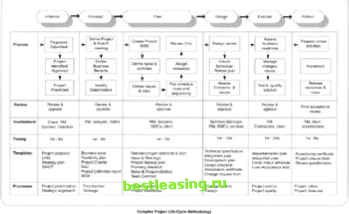

 |
 |

|
Промышленный лизинг
Методички
For numerous SDLC-type projects today, the trend and style of these methodologies frequently involve completing one phase after the next. Many are monolithic in nature; they are time consuming and some methodologists are calling these formal giants the dinosaurs of project methodologies. SDLC methodologies at least provide a framework for completing projects, but its not that these methodologies follow the often-quoted maxim Ye shall release early and release often ; rather, they rely on Ye shall wait till each phase is complete before releasing resources for the next. In todays complex digital world, where faster is better, project managers struggle to complete projects where complex, unknown technologies are being used. Clients do want to see results much earlier than before. They insist that you follow a project approach, but they want to see results much more quickly and want deliverables to be delivered sooner. My advice is to go through the various approaches mentioned here and select one that is best suited for your needs, and tailor it accordingly. In addition, refer to Chapter 4 of this book to start a journey into methodologies (see Figure 3.6).  Figure 3.6: Complex life-cycle methodology. Approach Needs analysis. This phase is used to determine the specific client requirements for the proposed solution. The needs analysis aids in identifying the exact business and functional requirements. Project concept. The project concept establishes the business objectives and assumptions, risks, and deliverables into a project concept, which is usually documented and presented to the client for acceptance. Project design. This phase allows the project design or development team to begin creating or formulating the design for the solution. Project training. The training phase is an important part of this methodology because it includes training as part of the project. It assumes that training for the user is necessary. Project delivery. The implementation of the project occurs after training has taken place. This phase ensures that the project is delivered at the relevant location(s) within schedule. Project support. This phase of the project ensures that the necessary support for the solution has been coordinated and managed. Tasks such as support level agreements (SLAs), escalation processes, and contact lists are performed. ЦШиН1:1 N PREVIOUS IN NEXT I 1 2 3 4 5 6 7 8 9 10 11 12 13 14 15 16 17 18 19 20 21 22 23 24 25 26 27 [ 28 ] 29 30 31 32 33 34 35 36 37 38 39 40 41 42 43 44 45 46 47 48 49 50 51 52 53 54 55 56 57 58 59 60 61 62 63 64 65 66 67 68 69 70 71 72 73 74 75 76 77 78 79 80 81 82 83 84 85 86 87 88 89 90 91 92 93 94 95 96 97 98 99 100 101 |
|||||||||||||||||||||||||||||||||||||||